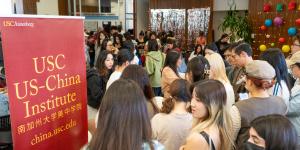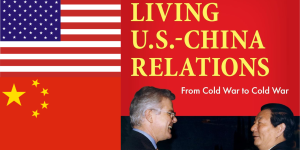Join us for a free one-day workshop for educators at the Japanese American National Museum, hosted by the USC U.S.-China Institute and the National Consortium for Teaching about Asia. This workshop will include a guided tour of the beloved exhibition Common Ground: The Heart of Community, slated to close permanently in January 2025. Following the tour, learn strategies for engaging students in the primary source artifacts, images, and documents found in JANM’s vast collection and discover classroom-ready resources to support teaching and learning about the Japanese American experience.
U.S. politics
Congressional Research Service, “China: Possible Missile Technology Transfers from U.S. Satellite Export Policy – Actions and Chronology,” September 5, 2001
This report was written by Shirley A. Kan.
Myers, Oksenberg, Shambaugh, Making China Policy: Lessons from the Bush and Clinton Administrations, 2001
Matthew Flynn reviews the book for H-Diplo, March 2003, credit H-Asia.
Selection from American Military History-The U.S. Army in Vietnam, 1989
Chapter 28, The U.S. Army in Vietnam by Vincent H. Demma
Taiwan Relations Act, 1979
To help maintain peace, security, and stability in the Western Pacific and to promote the foreign policy of the United States by authorizing the continuation of commercial, cultural, and other relations between the people of the United States and the people on Taiwan, and for other purposes.
Address by President Gerald R. Ford at the University of Hawaii, December 7, 1975
President Ford's speech at the University of Hawaii after returning from his trip to China. Excerpted from the Gerald R. Ford Presidential Library & Museum.
Richard Nixon, Remarks upon Returning from China, Feb. 28, 1972
Remarks made by President Richard Nixon after his trip to the People's Republic of China.
Richard Nixon, "The Journey to Peking," from the Third Annual Report to the Congress on U.S. Foreign Policy, February 9, 1972
Part of a larger report on U.S. foreign policy. The report was delivered to Congress only days before Nixon left for China.
Tonkin Gulf Resolution, August 7, 1964
The Tonkin Gulf Resolution is of historical significance because it gave U.S. President Lyndon B. Johnson authorization, without a formal declaration of war by Congress, for the use of conventional military force in Southeast Asia. Specifically, the resolution authorized the President to do whatever necessary in order to assist "any member or protocol state of the Southeast Asia Collective Defense Treaty." This included involving armed forces.
United States - Chinese Joint Statement December 1, 1954
A 1954 security pact between the Republic of China (Taiwan) and the United States
Message From the United States President to the Emperor of Japan, 1941
One day before the Japanese attacked Pearl Harbor with 420 airplanes, President Franklin D. Roosevelt sent the following message to the Showa Emperor of Japan.
Pages
Featured Articles
Please join us for the Grad Mixer! Hosted by USC Annenberg Office of International Affairs, Enjoy food, drink and conversation with fellow students across USC Annenberg. Graduate students from any field are welcome to join, so it is a great opportunity to meet fellow students with IR/foreign policy-related research topics and interests.
RSVP link: https://forms.gle/1zer188RE9dCS6Ho6
Events
Hosted by USC Annenberg Office of International Affairs, enjoy food, drink and conversation with fellow international students.
Join us for an in-person conversation on Thursday, November 7th at 4pm with author David M. Lampton as he discusses his new book, Living U.S.-China Relations: From Cold War to Cold War. The book examines the history of U.S.-China relations across eight U.S. presidential administrations.




